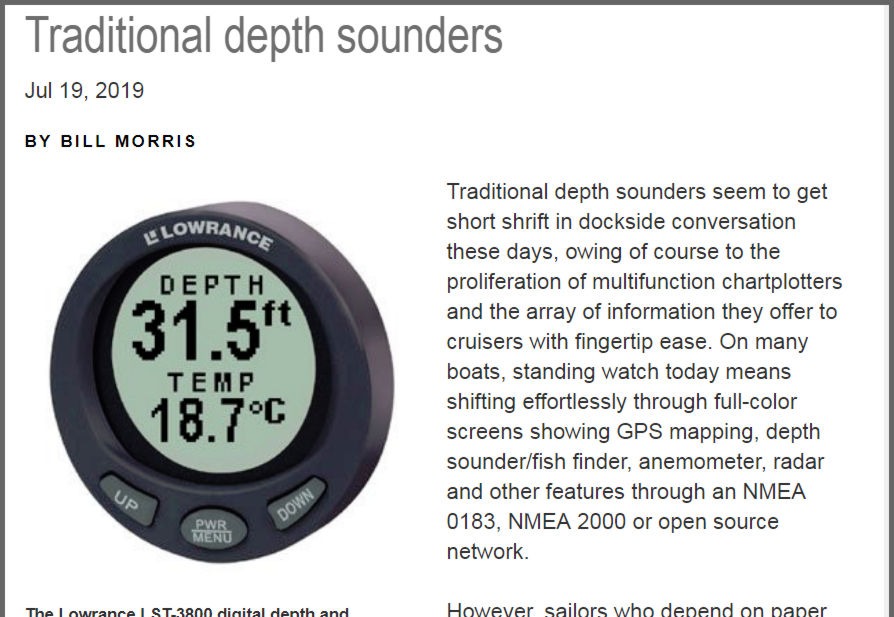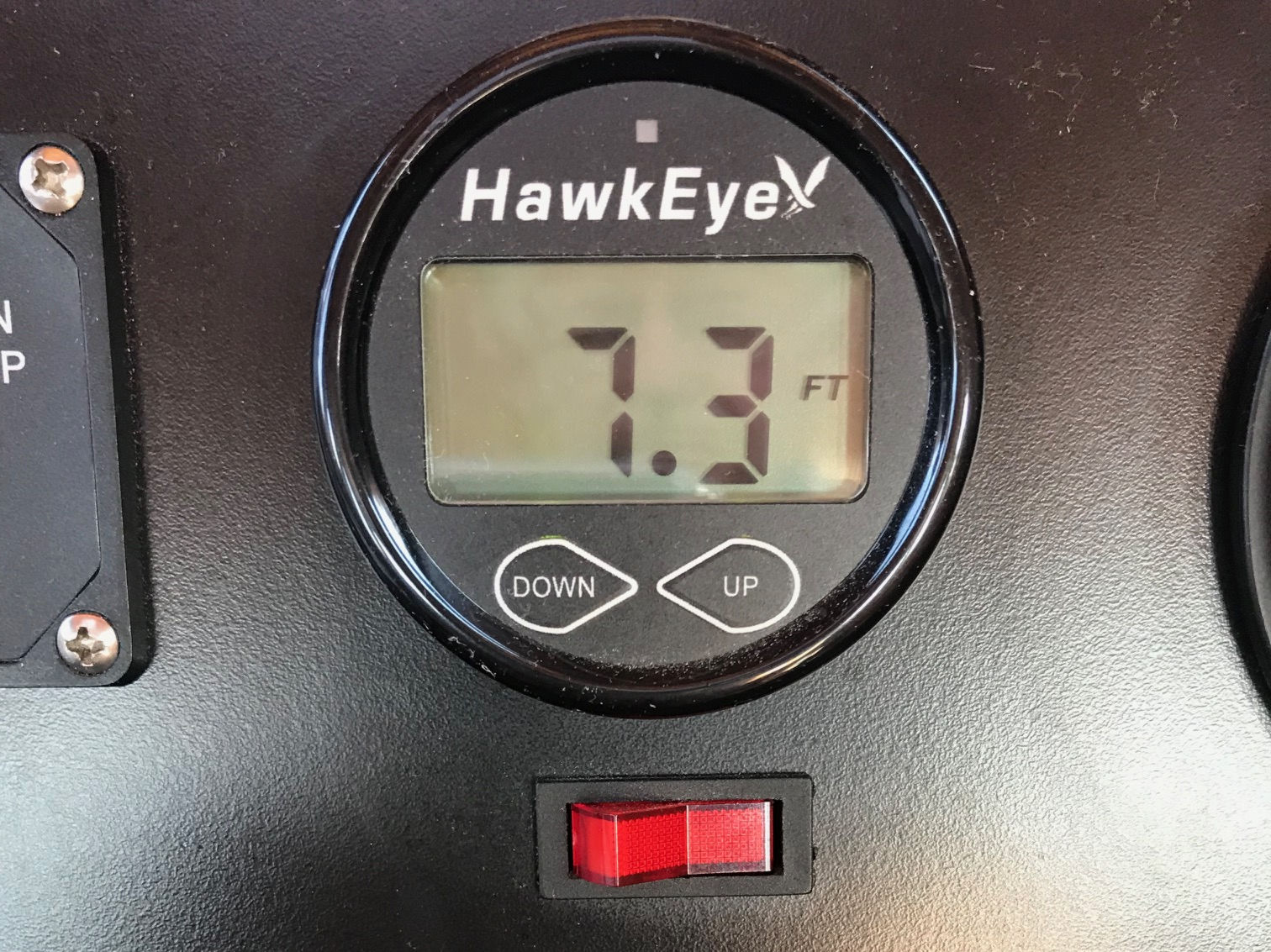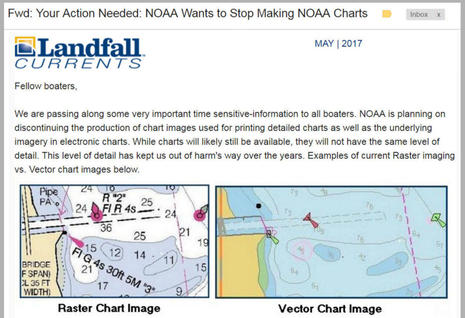Dedicated Depth display, NMEA 2000 the best way?

I enjoyed this Bill Morris article at OceanNavigator.com even though he pokes fun at skippers like me. For one thing, he does it gently and well, as in this smoothly written second paragraph:
However, sailors who depend on paper charts and minimal electronics — VHF radio, hand-held GPS and a stand-alone depth sounder — are still making successful ocean passages, blissfully innocent of the compulsion, or ability, to spend big bucks on more elaborate systems.
I also agree with Bill that a dedicated depth display is a key navigation tool, regardless of what else you’re using. But then again I think that there are better ways to do it than he advocates, and though they involve bigger bucks in the short term, that may not be true over time.
The standalone Lowrance LST-3800 Depth gauge that Morris favors reminded me of the vaguely similar Lowrance LMF-400 I tested 11 years ago. Of course, the LMF is an NMEA 2000 all-in-one instrument display capable of showing many types of information, but you can certainly use it as a dedicated depth display (in fact, most let you turn off all other pages if you actually can’t control your fingers).
Moreover, I still have that inexpensive LMF-400 and when I plugged it into Gizmo’s N2K network it powered up and had no trouble showing the Depth data available (and possibly shown by most any other display on the network). By contrast, the standalone LST-3800 system requires both display and transducer to be functional. And while the LST is only $162 on Amazon, that included transom-mount transducer is not apt to work well with the inboard engines found on most ocean-going boats, and I’d be skeptical about an optional Pod Style transducer in-hull install too.
It’s also worth noting that even the LMF’s inefficiently designed numeric Depth display is probably easier to read than what’s on the significantly smaller LST display. And how about that Furuno FI70 for crisp and bright readability! Its high-quality 4.1-inch color screen is fairly typical of current NMEA 2000 instruments and I just bought it on eBay for $300.
I would hesitate to buy a used NMEA 2000 depth transducer like, say, a rugged yet reasonable Airmar DT800 — or any used transducer, for that matter — but I’ve only seen one N2K display fail after many years of abusing them, often six or more of various brands at once.

Garmin GMI20 Depth graph with adjustable time period 
Furuno FI70 Depth graph set to center on 20-foot range 
Maretron DSM410 split-screen graph and numeric Depth 
FI70 showing extra info but with Depth still in big digits
Sure, setting up a NMEA 2000 network can seem complicated and expensive but most of the gear is built well for blue water boating (and note the value-oriented sensor/display kits available from Garmin, B&G, and others). And I simply do not buy the notion that a standalone depth sounder is more reliable.
I’ve never seen an N2K network fail completely, and I’ve built some that stretched the rules. And there’s more redundancy than the fact that most any screen can show basic data like Depth. You can also have an extra depth transducer on the network, and in most cases, the displays will pick one automatically or let you set up a preferred source. In fact, some displays like Maretron’s will let you see two different Depth readings on the same screen and even name them sensibly, like Port Depth and Starboard Depth based on a big catamaran’s dual transducers.
You might feel a little “compulsion” to try alternate Depth displays like the ones above, which I created and photographed on Gizmo while she was tied up yesterday. But once you’ve crafted what works for you, there’s no need to fool around when you should pay attention elsewhere. In my view “keeping it simple” is not about what marine electronics can do, but is about how you use them.
How would you advise a friend looking for a simple Depth data display?
PS 8/1: Allan Seymour sent in this photo of a HawkEye DepthTrax mounted at the helm of Sally W, which also has Depth on its N2K network (as seen on Panbo). He wrote, “When at anchor I keep this little guy on. Draws little power. It’s also a very simple backup.”





















having just gone thru a similar process, I do agree with Ben.
A dedicated (larger) display for depth becomes an immediate “go to” for this most important peice of info… which otherwise can often get lost amongst the many items displayed on the MFD.
And with the newer “3D” and like “multi sensor” requirements, I replaced the older single transducer with a double setup to optimise side/3D vision – by reusing the old transducer thru hole position for one of the transducers.
Also – for those of us with flybridge and lower helm positions, the ease and flexibility offered by an N2K based depth sounder for dual helm displays – certainly adds flexibility.
One point that could be valid for a “single sensor/dedicated” depth system : when at anchor and trying to minimise power consumption, being able to turn off N2K network and MFDs & just enable a dedicated depth display will definitely have a lower power consumption. – particularly with larger MFDs and complex N2K networks with higher LENs.
I think I would tend to agree with you, Ben – I can see a dedicated depthsounder system for a very small vessel – for a runabout or daysailer, for example – where the criteria might be convenience of mounting, ruggedness of the display and low power drain. But on a larger cruising boat, the utility of having a depth display at multiple locations far outweighs other considerations. Having now installed an instrument in the aft stateroom, I wouldn’t want to be anchored without having depth visible to me at any hour day or night 🙂 . In the cockpit, having depth on both a standalone display and on the MFD is also very convenient.
Ben
Every conversation on depth sounders seem to concentrate on the ability to read deep depth with little or no conversation on the units that will accurately shallow depths (less than 5 feet). Our boat drafts just 3 foot and we would like to find an N2K depth transducer to thru-hole (or in hull, we now have an Airman P79 that blanks out at 5ft under the keel) that will accurately measure under 6 feet. Maybe a pole over the side is the only option…. for reading shallow water depths. But given the technology of today there has to be a better way?
Thanks
Quiet Company
Great Harbour GH47
Back when I used to work at small inland boat dealerships I played with lots of cheap fishfinders, I found lots of the humminbird and some of the garmin units did pretty well in really shallow water as low as 2-3 ft. I would assume they may have gotten better since then since lots of the bass guys spend lots of time in the shallows, and that’s the biggest market. I know lots of the small trailer sailor guys also run fishfinders for that reason. A family member picked up a Humminbird Helix for his 19′ sailboat but we haven’t had a chance to install and test it yet.
Colin, I think that a lot of sailors also like to see the depth trend you get with a fishfinder display, which is why I like those instrument depth over time graphics I showed in the entry.
Hi Norm, I’m wondering if that P79 is working right. I rarely go in waters under 5 feet deep but don’t recall any thru-hull NMEA 2000 or fishfinder transducers failing at that depth, and they’re closer to the bottom by 1.5 to 2.5 feet. Right now, that’s five transducers on Gizmo.
Ben
Thanks for the Reply! My present Sounder is an Airmar P79 In-Hull Transducer. It connect to our N2K Maretron Backbone. In talking with Airmar they indicate that the issue is that at shallow depths, the reply from the sounder hitting the shallow bottom comes back faster than the sounder can switch from “Send” to “Receive”. But Since I’m shooting through the solid fiberglass thick hull of our Great Harbour, A thru-hull transducer “Should” have a quicker transition and there-by read a lower depth. They suggest a Airmar DT-800. Given your comments it make sense to me.
I don’t think this is an either / or question. Redundancy is your friend.
Knowing the depth at all times – even at anchor demands redundancy.
In my single helm Nordic Tug 37, I have three Depth sounders:
One Airmar through-hull transducer that feeds the Furuno TZT15 Plotter and the laptop via NMEA 2000. (I turn the plotter off at night at anchor as it is quite bright and draws significant amount of power.
I have a standalone Raymarine Dragonfly 5 with its own through-hull transducer that displays bottom detail and depth. This is always on when we are out
The final backup is a simple Faria shoot through the hull sounder that is placed further aft and displays depth below the keel.
When underway, I prefer to have the Chart plotter and Radar displayed as a 2 pane split screen with the Airmar transducer depth as a simple numeric on the MFD. The Raymarine gives me the graphical display and my at a glance bottom picture.
This setup allows for 2 sounders to be on at all times with minimal draw and should the NMEA 2000 or any one of these fail, I have backup. I can also get a depth value closer to the stern. When swinging at anchor or stern tied in tight anchorages, I have a better sense of how much clearance I have aft.
I do think there is still a role for the standalone simple transducer.
-evan
I have had the N2K network fail. In my case it was an early life failure of a N2K to Wi-Fi adapter. First indication was slow updates on my i70’s followed by a hard turn to port from the pilot. Once relieved of helm duty I quickly found the offending device – it was extremely hot, and de powered the network, but didn’t consume enough to blow the recommended fuse. Once removed, everything came alive immediately. The vendor replaced (with N2K connector rather than SeaTalkNG) it promptly and works great ever since.
I won’t say they never go down, but they are easy to remove devices and start working with out rebooting. This is a big plus in rapid troubleshooting.
My network is slightly bigger than most with ~15 devices currently connected.
Hi Ben, can you pls post a link to the eBay seller who is offering the Furuno FI-70 for $300? Sounds like a great deal on the versatile display.
Drew, the seller (an installer I’m pretty sure) only had one and eBay oddly shows what he asked, not what he took, but here t’is: https://www.ebay.com/itm/283441577266
I do see numerous Furuno FI-50 N2K instrument displays at reasonable prices on eBay, and my experience with them years ago was quite positive:
https://panbo.com/?s=Furuno+FI-50
I networked my ancient ST60 to my Seatalk/NG network in about 10 minutes. One transducer, many displays.
Hi Ben,
One item overlooked in the discussion above is the incredibly useful depth alarm that most dedicated depth sounders have. I recently upgraded my depth display from my older Navman package to Garmin NMEA 2000 GNX 20 & 21 with an Airmar DST800. I was very surprised when I found there is no depth alarm! As full-time cruisers, we are at anchor most of the time and setting shallow and deep alarms provides extra safety in conjunction with an anchor alarm. The shallow alarm is also something I count on when navigating near coasts or entering an anchorage. I mounted the GNX 21 next to my bunk so I can monitor to depth at night. That any company would sell a transducer and depth display that doesn’t have an alarm is unfathomable to me (pun intended). Luckily, I also purchased a GMI 20 to use for displaying wind and I am able to set the depth alarm on that display… although it takes a ridiculous 9+ button pushes to set or disable it. Unfortunately the alarm only beeps at the GMI 20 at the helm and not at the GNX 21 near my bunk. The Garmin instruments have some nice features but there are several glaring design flaws. Another example being that the depth trend graph is completely backward making that piece of data useless and potentially dangerous. Oh, to be able to test drive instruments in the real world before buying… Better yet, to have design engineers who actually cruised with their creations.
Cheers,
Bruce
s/v Migration
Hi Bruce,
I checked almost all simple small N2K instruments (Raymarine, Garmin, etc.) on the market, but one I really liked best was the B&G Triton 2. Also got it recommended by several sailors who was dissatisfied by their Garmin instruments (even though they lacked other features than the missing depth alarm). It really simple to use, but at the same time really outshines all Raymarine and Garmin units I have tried. It is that much better IMHO.
If you get one, it really has a simple to use depth alarm, and it can also be displayed and acknowledged on any other B&G instrument on the boat, if you want several of them (we have such a small boat that one is enough).
If you do get one (or two), take a look at page 58 in the Triton 2 manual, “Enabling the alarm system and the alarm siren”, to see how you can setup a depth alarm very simply.
https://www.manualslib.com/manual/1224005/BAndg-Triton2.html?page=58#manual
For general info:
https://www.bandg.com/bg/type/instruments/triton2digital-display
Complete manual:
https://ww2.bandg.com/downloads/triton-2-owners-manual/
It also came out as top #1 instrument when Practical Boat Owner tested almost all N2K instruments in the market two years ago. Really one of the best also in my own comparison (Ben’s Furuno is also a great one, even if I personally prefer the Triton).
Hi Ben,
Good article and comment. I agree with your response and thinking here.
I have only a small sail boat, but agree that N2K is a great enabler on boats (both small and big). I have complemented my Raymarine Axiom and B&G MFD with a small Triton 2 instrument, that is great for showing depth in big easy numbers. In difference to MFD’s it also draws very little power (especially important on a small sail boat).
Got my brand new Triton 2 on sale in the end of last summer for $299. Great and simple to use instrument addition to the boat. I can really recommend to have a Triton 2 (or any such instrument from other manufacturers) on any N2K equipped boat.